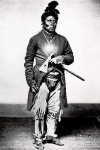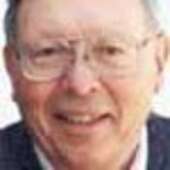Sky Chief of the Pawnee tribe
Monday, June 28, 2010

Sky Chief
When the white man first came to what is now Nebraska, the Pawnee Nation could boast of a population of some 10,000, in three tribal sections. They were considered among the most advanced of the Nebraska Indian peoples in farming, handicrafts, music, medicine and religion, and the Pawnee methods were imitated by other tribes. But over the years. The Pawnee tribes were reduced in numbers by a series of disasters -- cholera, drought, and continuing attacks from their traditional enemies, the Sioux. Pawnee women, who did most of the farming, were in constant danger of attack while attending their fields.
By the 1870s, the Pawnee Nation numbered no more than 4,000. Their tribal land, which had at one time included most of what is now Nebraska, had been reduced to only the land between the Platte the Republican Rivers, and even the right to this land was challenged by the larger Plains tribes, the Comanche, Cheyenne, Utes, Arapahoes -- and especially the Sioux.
Among the Pawnee chiefs at this time was Sky Chief. Sky Chief had taken over for his father, one of the great Pawnee Chiefs, who by this time was old and infirm, and was no longer able to lead the annual buffalo hunt to Southwestern Nebraska.
Sky Chief had begun to make a name for himself among the Pawnee. He was a leading advocate of the "Accommodation" treaty with the U.S. Army. Under this treaty, the Pawnee supplied scouts for the Army, and guards for the transcontinental railroad, which at the time was pushing west across the prairie. In return, and most importantly for the Pawnee, the Army provided protection to the Pawnee Nation against their Indian enemies.
The summer buffalo hunt was the high point in the year for the Pawnee. The 1873 hunt was a massive affair, and was to prove to be the last of the great buffalo hunts. Sky Chief, Sun Chief, and Fighting Bear were the leaders of a great Pawnee expedition, perhaps numbering some 250 warriors plus 100 women and 50 children.
Their objective was to hunt buffalo along the banks of the Republican River, to what is now Trenton. The party was entirely peaceful, and it was a joyous time for the Pawnee. Nevertheless, when they reached the north bank of the Republican (at Trenton), guards were posted around the camp, as it was feared that there might be Sioux in the area.
Early in the morning of Aug. 4, 1873, the Pawnee hunters began their hunt, moving north, up the divide, between the Republican and Frenchman Rivers, followed closely by the women and children who processed the buffalo kills. Sky Chief had just killed a buffalo and was in the process of skinning the animal when an advance guard of a Sioux war party came upon the scene and killed him, thus beginning the battle that we know today as the Battle at Massacre Canyon.
As soon as the firing began, John Williamson, the white Indian agent who had been sent along with the Pawnee, to supervise the hunt, lend counsel to the Indians, and generally keep an eye on things, rode out to meet the Sioux, carrying a white flag of truce. He meant to bring a stop to the firing, by negotiating with the Sioux. When his horse was shot out from under him, he was forced to retreat and the battle was drawn.
It was not much of a battle. Massacre is an apt name. Sioux warriors, with a 4-to-1 advantage over the Pawnee, quickly joined the advance party. While Pawnee warriors, women and children dropped everything and fled down the canyon toward the Republican, Sioux warriors from the Brule and Oglala Sioux tribes rode along the ridges, on either side of the canyon, firing down on fleeing warriors, women and children. When the carnage ended, Sky Chief and 69 Pawnee warriors, women and children were dead (some reports say as many as 150), as the result of the Sioux attack. It is generally conceded that only six Sioux warriors died in the battle.
The Sioux broke off their attack as suddenly as they had begun, feeling that their objective had been accomplished. The Pawnee survivors retreated down the Republican Valley as quickly as they could manage, leaving behind some 500 hides and meat -- their entire gathering from their summer's buffalo hunt. They finally regrouped at Royal Buck's Red Willow settlement, where they were met by a contingent from the U.S. 3rd Cavalry, out of Fort McPherson. The Army helped provide the survivors with food stuffs, and then accompanied them back to their reservation at Genoa.
The Battle at Massacre Canyon was an important event in the history of the west. It was the last inter-tribal battle in Nebraska. It signaled the last great buffalo hunt. It caused the Pawnee to give up their Nebraska reservation, in exchange for land in the Indian Territory. It caused the Pawnee to leave Nebraska, their traditional home, and move to the Indian Territory in present-day Oklahoma.
On the north side of Highway 6 & 34, between Cambridge and Holbrook, nestled into the trees as the base of the bluffs that rise from the Republican River is a home belonging to Joyce and the late Dr. Bob Spear.
Beside one of the spring-fed ponds is a monument, that in 1924, was dedicated to the great Pawnee Chief, Sky Chief, who would bring his hunting party to these springs, to set up camp for their annual buffalo hunt. The top of the bluffs has been called "Arrow Head Haven" because of the many arrow heads that turn up after a rain. To the east of Spears' home, in the trees, there are strange mounds, marked as Indian Mounds by the Furnas County Soil Conservation Office.
The D.L. D. (Detroit-Lincoln-Denver) Highway passed close to the property, and in the 1920s there was a filling station on the south side of the highway, which featured refreshing, cool spring water for drinking and filling the canvas water bags that motorists hung on the outside of their cars, so that evaporation would keep the water cool.
In the 1930s, Dan and Margaret Dick expanded the attractions at "Sky Chief Spring Ranch." Dick taught instrumental music at the Cambridge school, but in addition he built a large pavilion, for roller skating and dancing. The dances were popular and Mr. Dick often played with the dance bands that appeared there. Later, in cooperation with "The Village of Cambridge," he put in a nine-hole golf course on 50 acres of pasture northwest of the farm buildings. This course was in use until Cambridge's new course was built in 1975.
Spring Ranch, Sky Chief's Campground, is a peaceful spot, and it is easy to imagine it as a welcome pause at a cool, restful oasis for Sky Chief's Pawnee hunting parties, or hot and weary travelers, traveling west in trucks and automobiles, on a torrid August journey (with no air-conditioning!).
Source: Massacre Canyon, by Paul Riley, A Touch of History, by Jackie Johnson

